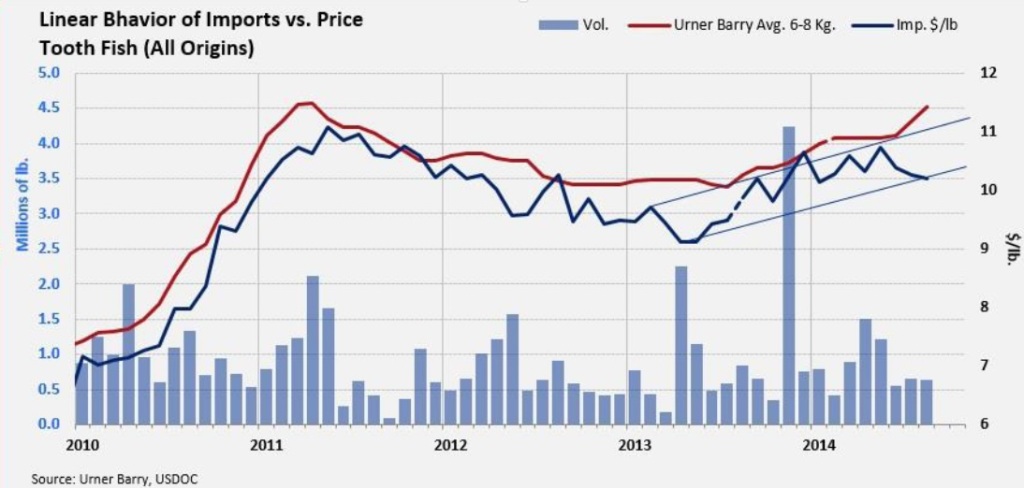Toothfish prices in the US are climbing this year as demand for sustainably certified product continues to put pressure on supplies. This higher toothfish interest has forced buyers to compete directly with Asian importers for product, which has pushed up the market in 2014.
So far in October, average Urner Barry prices for 6-8 kilo whole, frozen H&G toothfish are at record levels up over 14 percent from 2013. Meanwhile, frozen 6 oz. toothfish portion prices are averaging $15.10 per pound this month, up about 7 percent from last year and the highest since 2012.

US and Asian toothfish buyers have competed for more limited supplies of sustainable toothfish. This competition has run up prices to replace inventories, which has forced wholesale prices to new highs in 2014. Source: Urner Barry
The market has gone higher this year as toothfish demand has increased on the fishery’s rebuilt reputation as a sustainably fished resource. Over half the catch is now certified sustainable by the Marine Stewardship Council with another 60 percent of fisheries added to the Monterey Bay Aquarium Seafood Watch Program’s “Best Choice” or “Good Alternative” lists.
“Those changes are a result of the fisheries dealing effectively to eliminate IUU fishing, as well as substantial restraint and conservative Total Allowable Catches being set, along with environmental management measures such as implementing successful measures to retain seabird bycatch at near zero levels for the past decade or more,” said Martin Exel, the chairman of the Coalition of Legal Toothfish Operators.
The industry’s crackdown on IUU toothfish fishing Martin refers to has squeezed the overall supply of the product, legal or not. Since no IUU fish enters the US market, buyers here have been forced to compete with Asian importers who have started purchasing more legally fished toothfish. Additionally, both US importers and suppliers have added that general toothfish inventories have trended down on reduced catching quotas out of Chile and a decline in landings out of the Ross Sea.
“Given the reduced supply and increased requirement for MSC Certified toothfish, US companies lifted the stakes in order to secure enough fish from other fisheries to support the shortfall,” said Dylan Skinns, marketing manager for Austral Fisheries.
This competition is evident with a look at the higher costs US importers are currently paying to fill their toothfish inventories. Average prices buyers are placing to replace frozen wholefish are up 9 percent this year according to an analysis from Urner Barry.
So the general uptick in interest for toothfish here in the US, which has been driven by the industry’s push for sustainability, has been met with Asian needs for generally more limited supplies, and that has pushed up market prices here in the US.
In 2013 we wrote that it was time for to promote toothfish as a viable whitefish option for consumers and it appears the industry has done just that. Demand for sustainably sourced toothfish items both here and overseas, has kept supplies short and the wholefish and portion markets have advanced to record or near-record levels in 2014.
-taken from SEAFOODNEWS.COM by Michael Ramsingh
